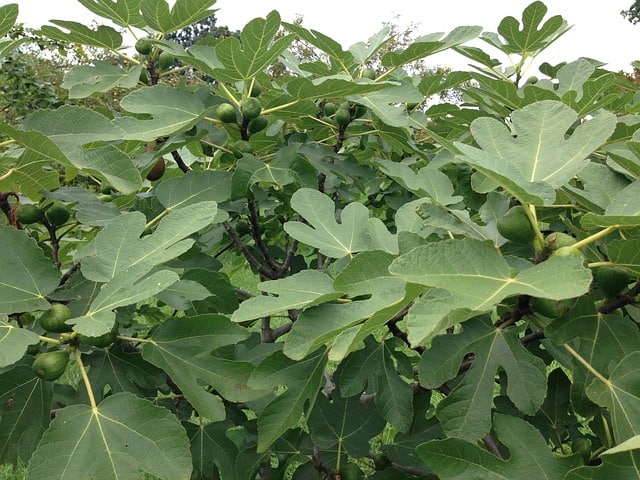Brown spots on my fig tree leaves can be a cause of concern. These spots can indicate a variety of issues, ranging from fungal infections to insect infestations. It’s important to identify the cause of the brown spots in order to take appropriate measures to remedy the problem.
One common cause of brown spots on fig tree leaves is excessive watering. Overwatering can lead to root rot, which can cause brown spots to appear on the leaves.
On the other hand, underwatering can cause leaves to dry out and turn brown as well. It’s important to strike a balance between the two and ensure that the soil is moist but not waterlogged.
Key Takeaways
- Brown spots on fig tree leaves can indicate a variety of issues, ranging from fungal infections to insect infestations.
- Excessive watering or underwatering can cause brown spots to appear on fig tree leaves.
- Gardeners should strike a balance between watering and ensure that the soil is moist but not waterlogged.
Other popular posts:
Identifying Brown Spots on Fig Tree Leaves
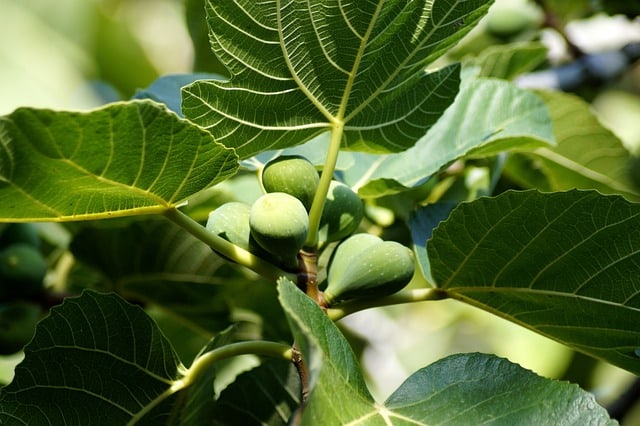
Brown spots on fig tree leaves are a common problem that gardeners face. These spots can be caused by a variety of factors, including diseases, pests, and environmental stress. Identifying the cause of the brown spots is essential to treating the problem effectively.
Brown spots on fig tree leaves can vary in color and size. They may be light brown, yellow, red, black, or appear as patches. In some cases, the leaves may also start to wither and fall off the tree, leading to significant leaf loss.
One of the most common causes of brown spots on fig tree leaves is a fungal disease called leaf spot. This disease causes yellow spots on the leaves that quickly turn brown. If left untreated, the leaves may start to wither and drop off the tree.
Another fungal disease that can cause brown spots on fig tree leaves is fig rust. The first signs of fig rust on fruit trees are tiny yellow spots on the underside of leaves. The rust on fig leaves’ underside then spreads to the upper portion, and the spots become reddish-brown.
Brown spots on fig tree leaves can also be caused by pests. For example, aphids are tiny insects that are black or green and can infest fig trees, causing brown stains on the leaves.
Another pest that can cause brown spots on fig tree leaves is spider mites. These pests suck the sap from the leaves, causing them to turn yellow and then brown.
Environmental stress can also cause brown spots on fig tree leaves. Overwatering or underwatering the tree can cause the leaves to turn brown and fall off. Similarly, too much or too little sunlight can cause brown spots on the leaves.
Brown Spots on My Fig Tree Leaves – 5 Common Problems
Brown spots on fig tree leaves can be caused by a variety of factors, including disease, infestation, weather, watering, soil, and nutrient deficiencies. In this section, we will discuss some of the most common causes of brown spots on fig tree leaves.
1. Disease and Fungal Infections
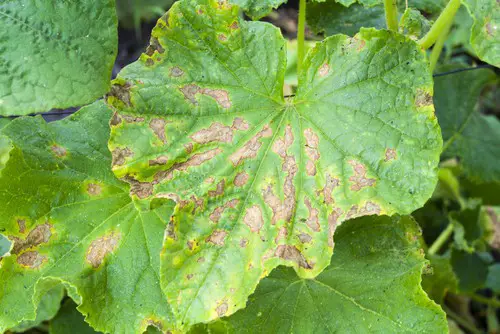
Leaf spot diseases, such as fig rust, can cause brown spots on fig tree leaves. Fig rust is a fungal disease caused by the fungus Cerotelium fici. It typically starts with yellow spots on the underside of the leaves, followed by reddish-brown patches on top.
To treat fig rust, remove dead and severely diseased leaves and spray the tree with a multi-purpose fungicide. Repeat the spraying with copper fungicide two weeks later.
2. Infestation
Bugs such as aphids, mealybugs, and spider mites can infest fig trees and cause brown spots on the leaves. They feed on the liquids from the plant, which can cause severe damage to the tree.
To treat a bug infestation, use an insecticidal soap or oil spray. Make sure to follow the instructions on the label and repeat the treatment as needed.
3. Weather
Hot, dry weather can cause brown spots on fig tree leaves, especially if the tree is not getting enough water. Fig trees prefer a warm, humid climate, so low humidity and high temperatures can stress the tree and cause brown spots on the leaves.
To prevent this, make sure to water the tree regularly and provide some shade during the hottest part of the day.
4. Watering and Soil
Overwatering or underwatering can cause brown spots on fig tree leaves. Fig trees prefer well-draining soil, so make sure the soil is not too compacted and has good drainage.
Use compost and mulch to improve soil quality and promote healthy root growth. Use a moisture meter to ensure the tree is getting the right amount of water, and adjust the watering schedule as needed.
5. Nutrient Deficiencies
Iron and nitrogen deficiencies can cause yellow or white spots on fig tree leaves, which can eventually turn brown. To prevent nutrient deficiencies, use a balanced fertilizer and make sure fallen leaves are leaching nutrients back into the soil.
Understanding the Impact on Fig Trees
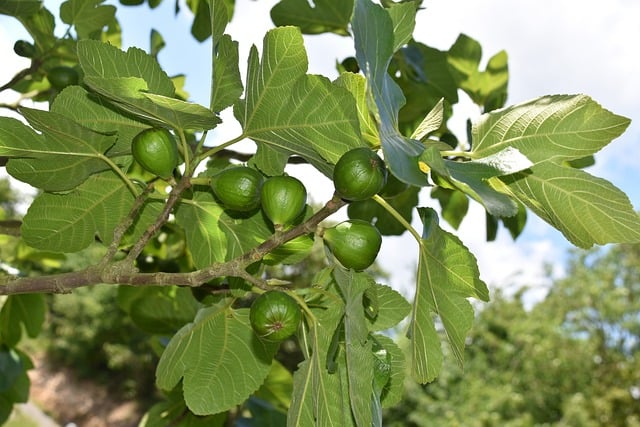
Fig trees are known for their delicious fruits and beautiful foliage. However, brown spots on the leaves can be a cause for concern for many home gardeners. These spots can indicate a variety of issues that can impact the overall health of the tree and its fruit yield.
One of the most significant impacts of brown spots on fig tree leaves is a reduction in photosynthesis. Photosynthesis is the process by which plants convert sunlight into energy.
Brown spots can interfere with the leaves’ ability to absorb sunlight, leading to a decrease in energy production. This can result in stunted growth, reduced fruit yield, and even death of the tree in severe cases.
Brown spots can also cause leaves to curl and drop prematurely. This can be particularly problematic for indoor plants or fig trees grown outside of their natural habitat. In California, for example, fig trees are often grown in containers and require extra care to prevent brown spots and other issues.
Home gardeners should be aware that brown spots on fig tree leaves can be caused by a variety of factors. These include fungal diseases, pests, and environmental stressors such as drought or excessive heat. It is essential to identify the underlying cause of the brown spots to determine the appropriate treatment.
Preventive Measures and Solutions
To prevent brown spots on fig tree leaves, it’s important to take preventive measures. Proper care and maintenance of the plant can help to keep it healthy and free from disease. Here are some solutions to consider:
1. Address Drainage
Brown spots on fig leaves can be caused by root rot, which is often a result of poor drainage. To prevent this problem, ensure that the soil is well-draining and that the pot has adequate drainage holes. Consider repotting the plant if the soil is consistently wet or if there is standing water in the pot.
2. Watering
Overwatering or underwatering can cause brown spots on fig leaves. It’s important to water the plant correctly by providing it with enough water, but not too much. Water the plant thoroughly, but allow the top inch of soil to dry out before watering again.
3. Sunlight and Air Circulation
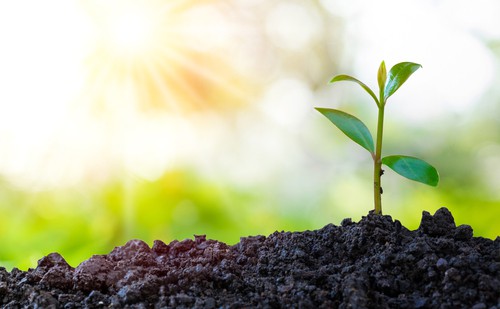
Direct sunlight can cause the leaves to burn and turn brown, or even fall off. Move the plant away from the window or out of direct sun. Ensure that the plant receives indirect sunlight for at least 6 hours a day. Good air circulation is also important to prevent the growth of fungi and bacteria that can cause brown spots on fig leaves.
4. Fertilizer
Applying the right amount of fertilizer can help to prevent brown spots on fig leaves. Use a balanced fertilizer, such as 10-10-10, and apply it according to the manufacturer’s instructions. Over-fertilizing can cause root burn and lead to brown spots on the leaves.
5. Pruning and Removing Leaves
Prune the plant regularly to remove any dead or diseased leaves. This will help to prevent the spread of disease and promote healthy growth. If the leaves have multiple brown spots, remove them immediately to prevent further spread of the disease.
6. Dormant Season
During the dormant season, reduce watering and avoid fertilizing the plant. This will help the plant to conserve energy and prepare for new growth in the spring.
7. Fungicides
If the brown spots on the fig leaves are caused by a fungal infection, consider using a fungicide. Copper sulfate or neem oil can be effective in treating fungal infections. Apply the fungicide according to the manufacturer’s instructions.
8. Lime
Adding lime to the soil can help to prevent fungal infections and improve soil drainage. Mix lime into the soil before planting the fig tree.
9. Evaporation
Covering the soil around the base of the fig tree with mulch can help to reduce evaporation and maintain soil moisture levels. This can prevent the soil from drying out and causing brown spots on the leaves.
By taking these preventive measures, you can help to prevent brown spots on fig tree leaves and keep your plant healthy and thriving.
Recognizing Other Leaf Conditions
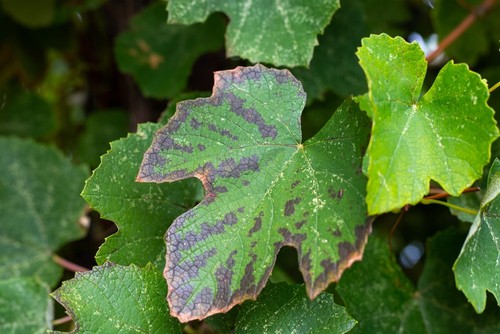
While brown spots on fig tree leaves can indicate a variety of issues, it’s important to recognize other leaf conditions that may appear on your plant. Here are a few common leaf conditions to look out for:
1. Dry Leaves
Dry leaves on a fig tree can indicate a lack of water or humidity. If the soil is dry to the touch, it’s likely that the tree needs to be watered. Additionally, fig trees thrive in humid environments, so if the air in your home is dry, it may be beneficial to use a humidifier near the plant.
2. Infected Leaves
Fig trees can be susceptible to a variety of pests and diseases that can cause leaf discoloration or damage. Common pests that can infest fig trees include aphids, spider mites, and mealybugs.
Diseases such as leaf spot or powdery mildew can also cause damage to leaves. If you suspect that your fig tree is infected, it’s important to diagnose the issue and take appropriate action to treat it.
3. Late Summer Leaves
In late summer, it’s common for fig tree leaves to turn yellow and drop. This is a natural process that occurs as the tree prepares for dormancy. As long as the leaves are dropping from the bottom of the tree and not the top, this is likely a normal occurrence.
4. Dormant Season
During the dormant season, fig trees may lose all of their leaves. This is also a natural process and doesn’t necessarily indicate a problem with the tree. However, if the tree doesn’t produce new leaves in the spring, it may be a sign of a more serious issue.
By recognizing these common leaf conditions, you can better diagnose any issues that may be affecting your fig tree. If you’re unsure about the cause of the leaf discoloration or damage, it’s always best to consult with a professional or do further research to ensure the health and longevity of your plant.
Frequently Asked Questions
How to treat brown spots on fig leaves?
Brown spots on fig leaves can be caused by a variety of factors, including overwatering, underwatering, sunburn, insect infestations, and fungal diseases. To treat brown spots on fig leaves, it is essential to identify the underlying cause first.
If the brown spots are caused by overwatering, reduce watering frequency and ensure proper drainage. If the brown spots are caused by underwatering, increase watering frequency and ensure the soil is moist but not waterlogged.
If sunburn is the culprit, move the plant to a shadier location or provide some shade. If insect infestations are causing the brown spots, use an insecticidal soap or neem oil to treat the plant. If fungal diseases are causing the brown spots, use a fungicide to treat the plant.
Fig tree leaves turning brown and curling?
If fig tree leaves are turning brown and curling, this could be a sign of underwatering or overwatering. Underwatering can cause leaves to dry out and curl, while overwatering can cause root rot, which can lead to brown and curled leaves.
Check the soil moisture level and adjust watering accordingly.
Brown turkey fig tree leaves turning brown?
If Brown Turkey fig tree leaves are turning brown, this could be a sign of fungal diseases, such as fig rust. Fig rust is a common fungal disease that causes brown spots on leaves, which eventually turn yellow and fall off. To treat fig rust, remove infected leaves and apply a fungicide.
Fiddle leaf fig brown spots on new leaves?
If Fiddle leaf figs have brown spots on new leaves, this could be a sign of sunburn. Fiddle leaf figs are sensitive to direct sunlight and can easily get sunburned. Move the plant to a shadier location or provide some shade.
Fiddle leaf fig leaves turning brown on edges?
If Fiddle leaf fig leaves are turning brown on edges, this could be a sign of underwatering or low humidity. Fiddle leaf figs need consistent moisture and high humidity levels to thrive.
Check the soil moisture level and adjust watering accordingly. Consider using a humidifier or placing a tray of water near the plant to increase humidity.
What causes rust spots on fig leaves?
Rust spots on fig leaves are caused by fungal diseases, such as fig rust. Fig rust is a common fungal disease that causes brown spots on leaves, which eventually turn yellow and fall off. To treat fig rust, remove infected leaves and apply a fungicide.

Hey, I’m Lisa and I’ve been an avid gardener for over 30 years. I love writing, talking and living in the garden! Feel free to connect with me on my socials below

